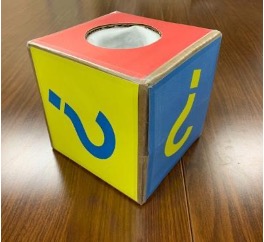 Larry secretly hides a triangle shape inside a special box. Then his friend Hallie reaches into the box and tries to identify the shape based on touch alone, without peeking at the shape. Hallie will need to rely on her math and executive function skills to identify the hidden shape. [The activity described here is from the DREME Guided Small Group Math Activity: What Shape Am I Touching?]
Larry secretly hides a triangle shape inside a special box. Then his friend Hallie reaches into the box and tries to identify the shape based on touch alone, without peeking at the shape. Hallie will need to rely on her math and executive function skills to identify the hidden shape. [The activity described here is from the DREME Guided Small Group Math Activity: What Shape Am I Touching?]
Executive function (EF) skills allow people to think about and control their behavior and thoughts. As described below, many classroom activities that promote geometry and spatial thinking skills also provide opportunities for children to practice their EF skills.
What Geometry and Spatial Thinking Skills Can Children Learn in Preschool?
With support from teachers and repeated practice, preschoolers can learn to:
- Notice that shapes and shape families differ in specific ways.
- Name and identify familiar shapes (g., circles) and unfamiliar shapes (e.g., pentagons).
- Describe properties of shapes that are similar.
- Describe properties that all members of a shape family have in common (g., different triangles all have three sides), and properties that differ between shape families (e.g., squares vs. triangles).
- Rotate and create shapes, both physically and mentally.
- Acquire math vocabulary and concepts (g., lines, sides, vertices, angles, corners).
Returning to the example in the vignette, Hallie’s knowledge about shapes helps her figure out that there is a triangle in the box just by feeling the shape inside the box.
How Are Executive Function Skills Used in Geometry and Spatial Thinking Activities?
Hallie’s EF skills make it possible for her to:
- Resist the urge to pull the shape out of the box before naming it (inhibitory control).
- Think of different strategies to use to identify the shape (cognitive flexibility).
- Keep track of how many sides and angles she has counted (working memory).
In this task and other classroom activities focused around geometry and spatial thinking, EF skills may support children’s ability to:
- Physically or mentally rotate shapes, such as in the DREME Center/Small Group Math Activity: Creating Copies, in which students copy a geometric design or building shown in a picture using blocks or square color tiles.
- Put shapes together to compose new shapes or figure out how to decompose a shape by taking it apart to make several separate shapes.
- Use working memory to create and follow maps.
Children can also practice EF and spatial skills during regular routines, such as in the DREME Math Moment: Get Attention Using Spatial Words, in which children must remember and follow a series of prompts.
Why Focus on Math and EF Skills?
First, many researchers have found that EF and math skills are related to each other, and that children’s EF skills are related to how well they complete math activities or learn math concepts or strategies [1]. Second, we focus on EF and math because both sets of skills are malleable—meaning that they can improve with practice [2, 3]. The DREME Guided Small Group Math Activities include built-in supports to help teachers prioritize teaching opportunities for children to practice their EF during spatial and geometry activities.
See the additional DREME articles on executive function and math to learn more about how specific EF skills play a role in math activities.
References:
[1] Mazzocco, M. M. M., & Kover, S. T. (2007). A longitudinal assessment of executive function skills and their association with math performance. Child Neuropsychology, 13(1), 18–45. https://doi.org/10.1080/09297040600611346
[2] Clements, D. H., Sarama, J., & Germeroth, C. (2016). Learning executive function and early mathematics: Directions of causal relations. Early Childhood Research Quarterly, 36(3), 79–90. https://doi.org/10.1016/j.ecresq.2015.12.009
[3] Banse, H. W., Clements, D. H., Sarama, J., Day-Hess, C. A., & Joswick, C. (2021). Supporting executive function development and early mathematics through a geometry activity. Young Children, 76(3), 75-82.